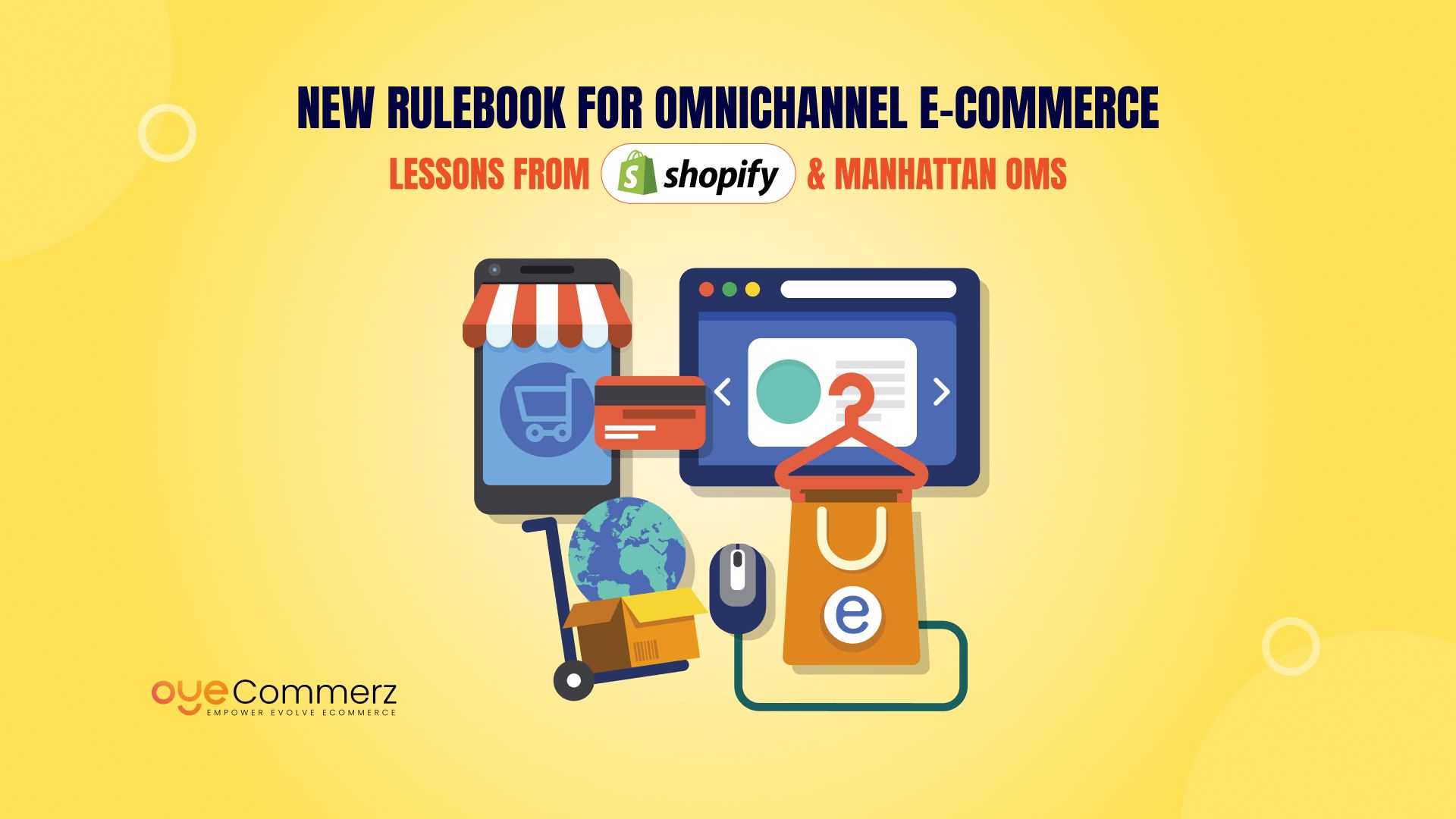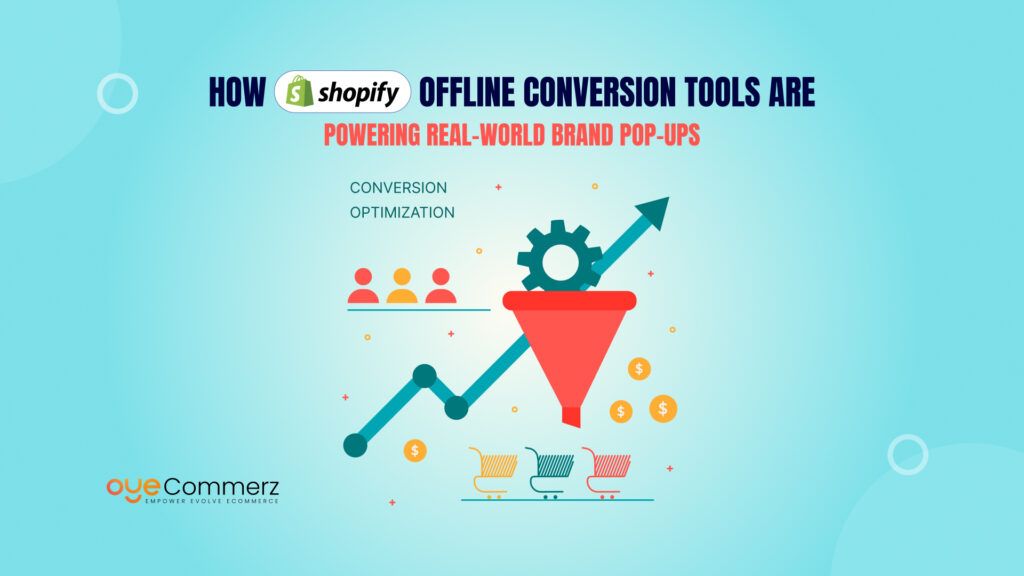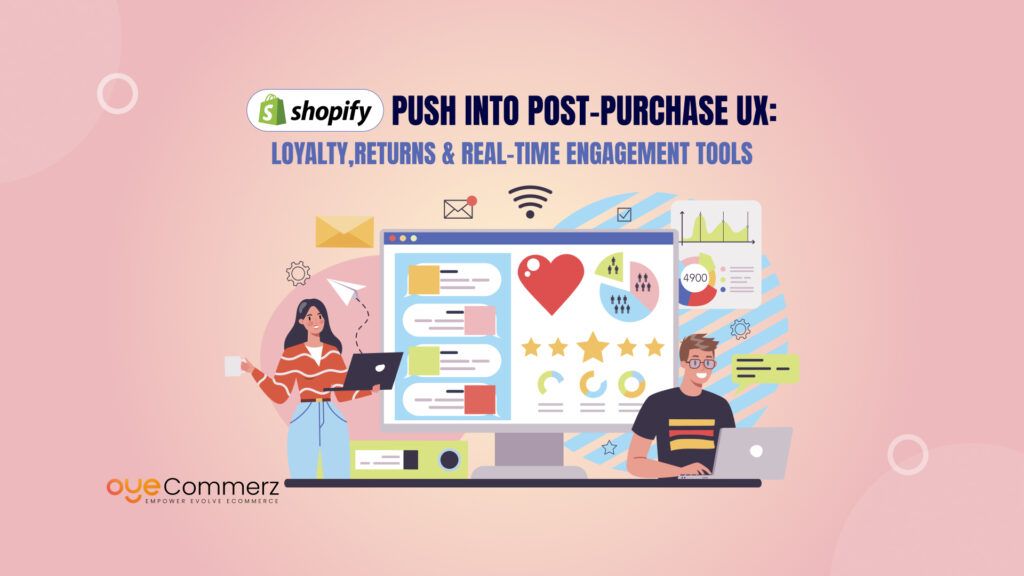74% of U.S. consumers expect a consistent and connected experience across all shopping channels whether it’s online, in-store, mobile, or social. Yet, most retailers are still struggling to unify their Shopify and Manhattan OMS sales, inventory, and fulfillment systems.
Traditional e-commerce platforms and outdated back-end systems were never built for today’s fast-moving, multi-touchpoint retail environment. They create friction between online and offline experiences, delay fulfillment, and limit scalability.
This powerful new collaboration is rewriting the rules of omnichannel e-commerce in 2025. By combining Shopify’s agile, merchant-first commerce engine with Manhattan Associates’ enterprise-grade Order Management System (OMS), businesses can now unlock real-time inventory, intelligent order routing, and seamless fulfillment across every channel.
In this blog, we’ll break down what this integration means, how it solves long-standing industry challenges, and why it’s the future of unified commerce especially for brands looking to scale fast without losing control.
Table of Contents
ToggleWhat is Omnichannel E-Commerce in 2025? (For Beginners)
Omnichannel e-commerce in 2025 is no longer a buzzword—it’s a business necessity. At its core, omnichannel means offering customers a seamless, consistent shopping experience across all platforms—online, in-store, mobile apps, marketplaces, and even social media.
Unlike multichannel, where each platform operates in a silo, omnichannel connects everything. Inventory is synced in real time. Customer profiles and order history follow them from web to store. A shopper can browse on Instagram, buy on your website, and pick up in-store—all without a glitch.
So where does Shopify and Manhattan OMS come in?
This partnership gives merchants access to tools that were once only available to massive enterprise retailers. Shopify provides the front-end agility and commerce experience. Manhattan OMS brings the back-end intelligence—like real-time inventory management, dynamic order routing, and store-level fulfillment optimization.
Together, Shopify and Manhattan OMS helps brands of all sizes deliver the kind of omnichannel experience customers now expect in the U.S.—fast, flexible, and frustration-free.
Whether you’re new to e-commerce or scaling a growing brand, understanding omnichannel is the first step toward long-term success. This is the year to stop thinking in channels and start thinking in journeys.
The Rise of Shopify and Manhattan OMS: What You Need to Know
As e-commerce evolves, so do customer expectations. Speed, accuracy, and flexibility are no longer “nice to have”—they’re essential. In response to this shift, Shopify and Manhattan OMS represents one of the most impactful partnerships to shape omnichannel retail in 2025.
Shopify, known for its fast, intuitive, and scalable commerce platform, powers thousands of DTC and B2B brands across the globe. It offers flexibility, speed to market, and a merchant-first approach that’s ideal for high-growth businesses.
Manhattan OMS (Order Management System), on the other hand, is a robust enterprise-grade solution designed to manage complex inventory, fulfillment, and order routing across multiple locations—warehouses, stores, and 3PLs. It’s trusted by global retailers for its reliability and depth.
The partnership bridges a critical gap.
Shopify’s strength in customer-facing commerce now connects seamlessly with Manhattan’s operational backbone. This allows merchants to manage inventory in real time, intelligently route orders based on location and cost, and fulfill from multiple points—all within one unified system.
For Shopify Plus merchants, this integration opens the door to enterprise-level fulfillment capabilities—without the heavy investment in legacy ERP systems.
Whether you’re looking to reduce split shipments, increase delivery speed, or gain a unified view of inventory across all locations, Shopify and Manhattan OMS gives you the tools to scale smarter and serve better.
Problems Legacy Systems Face in the Omnichannel Era
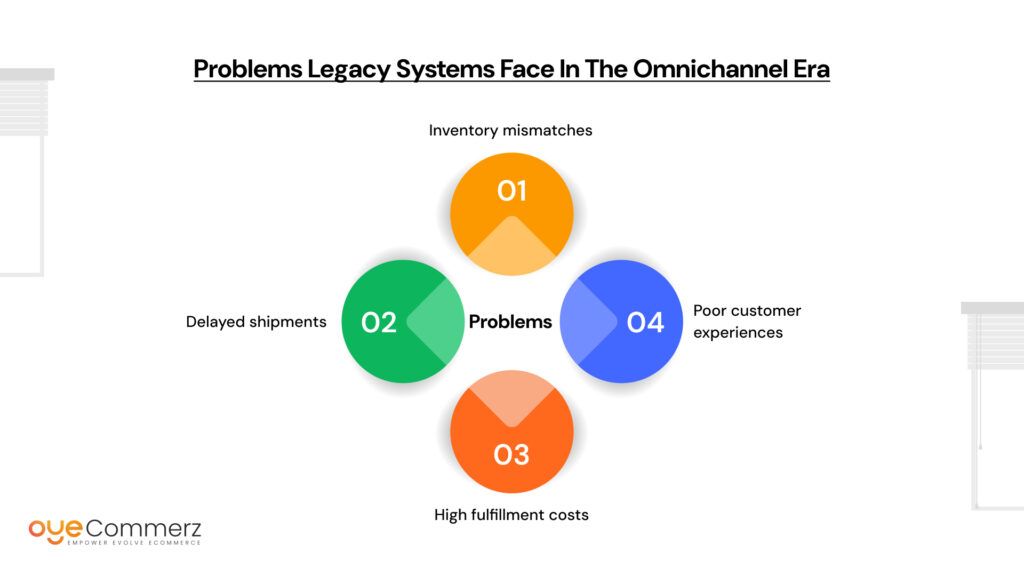
As customers move fluidly between online and offline channels, most retailers find themselves constrained by outdated systems that simply can’t keep up.
Legacy platforms and disconnected tools were not built for real-time commerce. Managing inventory across multiple locations, channels, and touchpoints becomes a manual, error-prone process that slows everything down—from order placement to final delivery.
Now multiply that at scale.
Without a unified system, retailers often face:
- Inventory mismatches that lead to overselling or lost sales
- Delayed shipments due to inefficient order routing
- High fulfillment costs from split shipments and last-minute logistics
- Poor customer experiences, such as canceled orders and delivery delays
These issues erode trust, reduce repeat purchases, and create unnecessary operational overhead. Even adding a new sales channel—like a marketplace or pop-up store—requires major development time or costly workarounds.
This is where Shopify and Manhattan OMS stands out. While legacy systems were built for a pre-omnichannel world, this partnership is engineered for today’s demands: unified inventory, real-time order management, and intelligent fulfillment—all in one system designed to scale with your business.
How Shopify and Manhattan OMS Solve These Challenges
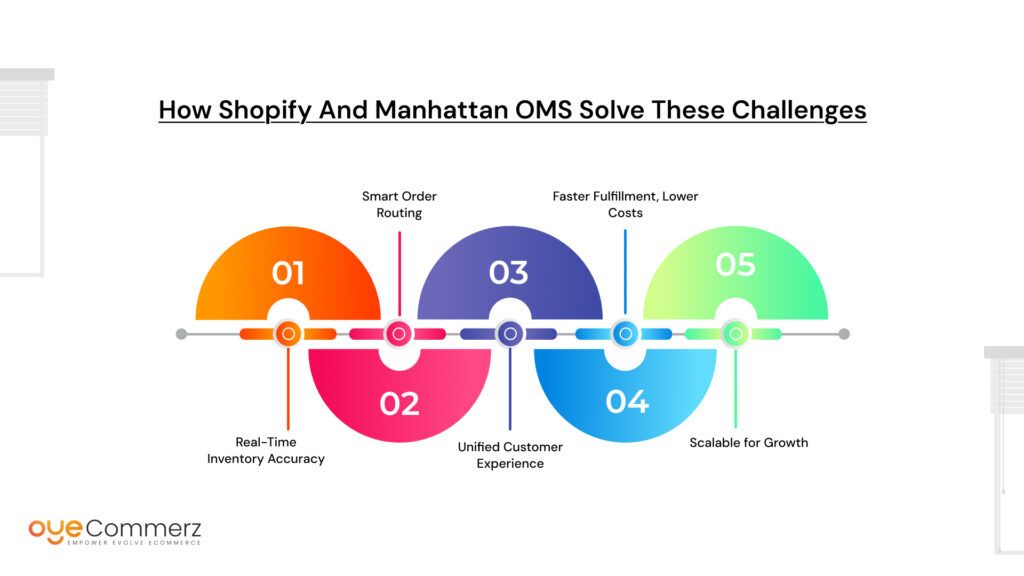
Legacy systems create silos. Inventory is disconnected. Orders are delayed. Customer expectations are missed. These are more than just technical issues—they’re business risks that can stunt growth, erode brand loyalty, and drain profits.
That’s exactly what Shopify and Manhattan OMS deliver. Together, they solve the most pressing challenges modern retailers face with a unified approach to inventory, fulfillment, and order management.
1. Real-Time Inventory Accuracy
No more guessing what’s in stock. The integration syncs inventory data across all locations and channels instantly, so you can avoid overselling and missed sales.
2. Smart Order Routing
Orders are automatically directed to the location that can fulfill them fastest and most cost-effectively—whether that’s a warehouse, a retail store, or a third-party logistics partner.
3. Unified Customer Experience
Whether a shopper buys online, picks up in-store, or makes a return from a different location, their journey is seamless. Shopify’s front-end experience is fully connected to Manhattan’s operational intelligence.
4. Faster Fulfillment, Lower Costs
By reducing split shipments and shipping from the nearest available inventory, you cut logistics costs and speed up delivery times.
5. Scalable for Growth
As your business expands, Shopify and Manhattan OMS scale with you. Add new channels, stores, or fulfillment partners without rebuilding your tech stack.
In short, this partnership offers more than just improved operations—it creates a foundation for sustainable, customer-centric growth. For any brand serious about omnichannel success in 2025, Shopify and Manhattan OMS provide a modern solution built to outperform outdated systems.
Omnichannel Tech Stack Breakdown (Beginner to Technical Deep Dive)
Building a successful omnichannel strategy requires more than just adding sales channels. It demands the right technology stack—one that’s capable of syncing inventory, orders, and customer data in real time across platforms.
That’s where Shopify and Manhattan OMS come together to offer a full-spectrum solution for both business users and technical teams.
For Non-Technical Readers: The Basics
Let’s break it down:
- What is an OMS (Order Management System)?
An OMS manages how and where your orders get fulfilled. It connects your inventory, warehouses, retail stores, and shipping providers so you can route orders efficiently. - What makes Manhattan OMS different?
It’s a robust, enterprise-grade platform that can handle complex fulfillment rules, multi-node inventory, and high-volume operations with precision. - How does Shopify fit in?
Shopify handles everything your customer sees—product pages, carts, checkout, and order history—while Manhattan OMS operates behind the scenes to ensure inventory is accurate and orders are fulfilled quickly and correctly.
For Technical Readers: The Integration Layer
The Shopify and Manhattan OMS integration works through middleware and APIs, ensuring both platforms communicate effectively in real time. Here’s how it functions:
- API Connectivity:
Shopify’s Admin and Storefront APIs work with Manhattan OMS to sync inventory levels, push and pull order data, and update fulfillment statuses. - Middleware Integration:
Many enterprise setups use an integration layer (like MuleSoft, Boomi, or custom-built middleware) to orchestrate the data flow between Shopify and Manhattan OMS. - Real-Time vs Batch Processing:
Real-time API calls enable live inventory updates and order routing, while batch processes can be scheduled for less time-sensitive data like reporting or bulk updates. - Scalability:
The system can be scaled horizontally, handling large volumes of concurrent API calls and transactions without latency or downtime. - Data Sync Precision:
Fulfillment, returns, inventory adjustments, and customer data are all continuously synchronized across the front-end and back-end systems.
This combination of agility and power is what makes Shopify and Manhattan OMS an ideal tech stack for omnichannel growth. It empowers teams to move faster, serve customers better, and scale without hitting operational roadblocks.
Comparison Table: Shopify and Manhattan OMS vs. Other OMS Solutions

When evaluating order management systems, it’s important to understand how different platforms stack up—especially when you’re planning for omnichannel growth, scalability, and customer satisfaction.
Shopify and Manhattan OMS offer a powerful combination that merges the best of e-commerce flexibility and enterprise-grade fulfillment. But how does this stack compare to other commonly used OMS platforms in the market?
Why Shopify and Manhattan OMS Stand Out
- Offers enterprise-grade features without sacrificing speed or flexibility
- Built for omnichannel-first brands, not just traditional ERP workflows
- Reduces tech overhead by integrating with the Shopify ecosystem
- Enables both growth-stage and enterprise brands to scale confidently
While other platforms can serve specific use cases, few offer the unified, modern infrastructure that Shopify and Manhattan OMS deliver—especially for U.S.-based brands focused on direct-to-consumer and retail expansion.
Contact to Migrate your Site to Shopify Now
Thinking About Migrating to Shopify? Let Oyecommerz Guide You
Adopting a powerful solution like Shopify and Manhattan OMS is a strategic move—but getting there requires the right partner.
Migrating from legacy platforms or outdated infrastructure isn’t just about switching storefronts. It involves syncing systems, preserving data integrity, and ensuring your tech stack can support omnichannel growth from day one.
A poorly executed migration can lead to downtime, lost sales, inaccurate inventory data, and broken customer experiences—especially when adding a complex OMS like Manhattan to the mix.
We specialize in seamless, secure Shopify migrations—whether you’re moving from Magento, WooCommerce, BigCommerce, or a custom-built system. Our team understands the nuances of integrating Shopify and Manhattan OMS, ensuring your operations are optimized for real-time performance, scalable order routing, and omnichannel success.
Why Brands Trust Oyecommerz:
- End-to-end migration support, including data, design, and integrations
- Manhattan OMS compatibility setup, tailored to your fulfillment needs
- Zero data loss, zero downtime approach
- Post-launch support and optimization to keep your store running at peak performance
If you’re planning to future-proof your e-commerce operations with Shopify and Manhattan OMS, Oyecommerz is the partner that gets you there—faster, safer, and smarter.
Conclusion
The omnichannel landscape in 2025 demands agility, precision, and seamless integration across every customer touchpoint. Brands that rely on outdated systems risk falling behind in a market where real-time inventory, smart fulfillment, and consistent customer experiences are table stakes.
Shopify and Manhattan OMS represent a new standard for omnichannel e-commerce—combining Shopify’s flexible, merchant-focused platform with Manhattan’s powerful order management capabilities. Together, they empower businesses to streamline operations, reduce costs, and deliver faster, more reliable service to their customers.
Explore our Shopify Migration Services and book a free consultation today.
If you’re ready to transform your e-commerce infrastructure and unlock the full potential of omnichannel commerce, now is the time to explore how Shopify and Manhattan OMS can work for your busines
Frequently Asked Questions
Omnichannel e-commerce refers to providing a seamless shopping experience across online and offline channels, such as websites, mobile apps, and physical stores. In 2025, it’s crucial for brands to adopt omnichannel strategies to meet customer expectations for convenience, personalization, and real-time inventory visibility.
Shopify offers built-in omnichannel features including Shopify POS, social selling integrations, inventory sync, and customer profiles that allow retailers to manage sales across online stores, social platforms, and physical locations — all from a single dashboard.
Manhattan Order Management System (OMS) is an enterprise-grade solution that optimizes order routing, real-time inventory tracking, and flexible fulfillment options like BOPIS (Buy Online, Pickup In-Store). It enhances omnichannel experiences by ensuring timely, cost-effective deliveries across all sales channels.
While Shopify is an all-in-one e-commerce platform ideal for SMBs, Manhattan OMS is a robust backend solution for complex fulfillment needs in large-scale retail. Shopify focuses on front-end and sales channels, whereas Manhattan OMS excels in backend logistics, order orchestration, and enterprise-grade fulfillment.
Businesses can integrate Shopify’s customer-facing platform with Manhattan OMS to unify digital and physical retail operations. This combination supports real-time inventory visibility, personalized customer experiences, and flexible fulfillment, ensuring a competitive edge in the 2025 omnichannel landscape.

